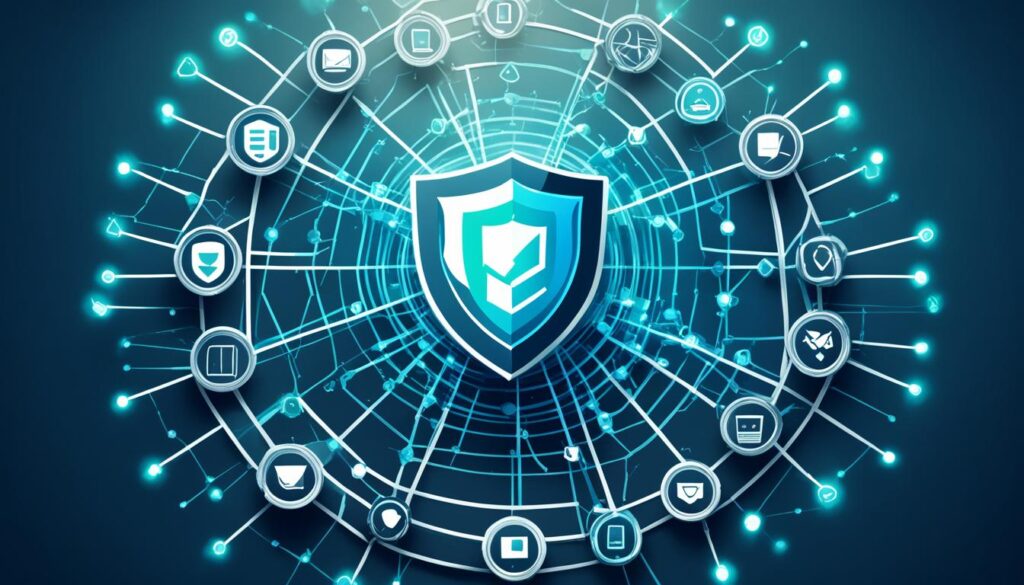Did you know cybercrime costs could hit $10.5 trillion by 2025? This shows we need strong cybersecurity training to protect our digital world. Our online safety workshop gives you the tools and knowledge to strengthen your cyber defense education.
This workshop matches up with global efforts, like the Government Accountability Office (GAO). They aim to share important cybersecurity info and build a cyber-aware community. You’ll discover the newest ways to protect your data and stop cyber attacks.
Cyber threats are growing fast, making it key to protect our digital info. You’ll learn how to keep your home network safe, use strong passwords, and stay safe with email. For more tips on online safety, check out our full guide here.
Key Takeaways
- Global cybercrime costs are projected to reach $10.5 trillion annually by 2025.
- Cybersecurity training is essential to safeguarding our digital environments.
- Workshops cover the latest cyber defense education strategies and practices.
- Aligns with GAO’s commitment to proactive cybersecurity measures.
- Learn to secure home networks, use strong passwords, and update software regularly.
Introduction to Cybersecurity
Cybersecurity is now key to protecting our digital world. It’s vital for both people and companies to know the basics to stay safe from online threats.
Definition and Importance
Cybersecurity means keeping systems, networks, and programs safe from digital attacks. These attacks can try to steal, change, or destroy important info, or even just cause trouble. Knowing how to prevent these attacks is crucial in today’s world where data breaches happen a lot.
Historical Context
The story of cybersecurity started in the 1970s and 1980s with the rise of computers. Early viruses like the Creeper virus led to the creation of antivirus software. Over time, cyber threats got more complex, leading to big improvements in cybersecurity.
From the Morris Worm in 1988 to the WannaCry ransomware attack in 2017, cyber threats have changed a lot. This shows we always need strong ways to prevent cyber attacks.
Current Trends
Now, cybersecurity is shaped by several big trends. More people working from home has led to more cyber attacks. Also, the rise of IoT devices has given hackers more ways to get in. Keeping up with the latest in cybersecurity and using good prevention methods is key to staying safe.
Understanding cybersecurity’s history and current trends helps us tackle digital threats better. Staying educated and alert is crucial in this fight.
Key Components of Network Security
Having a strong network security plan is key to keeping sensitive info safe and ensuring businesses run smoothly. Knowing the main parts helps companies set up good security steps.
Firewalls and Their Function
Firewalls are the first line of defense in network protection. They check all traffic coming in and going out based on set rules. This helps stop unauthorized access and lets only approved traffic in. There are different types of firewalls, like hardware, software, and cloud-based, to fit what a company needs. Using these firewalls makes secure networking better and helps fight off outside threats.
Intrusion Detection Systems
Intrusion Detection Systems (IDS) are key for spotting and dealing with threats in a network. They look at network traffic for anything that seems odd, which could mean a threat. Adding IDS helps in intrusion prevention and makes sure any strange activity is caught and stopped fast. For more info on IDS and other ways to defend your network, check out the Cybersecurity Workshop.
Virtual Private Networks (VPNs)
VPNs are crucial for keeping secure networking safe in remote and mixed work setups. They encrypt internet connections, letting people safely get to company resources from anywhere. This keeps data safe while it’s moving and makes sure only the right people can see sensitive stuff.

In short, using firewalls, IDS, and VPNs together is key for good network protection. These tools help companies boost their security and fight off many cyber threats.
The Role of Ethical Hacking
Ethical hacking is now key in cybersecurity. It involves testing systems to find weaknesses and suggest ways to improve security. This is vital for companies to protect their online assets.
What is Ethical Hacking?
Ethical hacking means testing systems with permission to find security issues. It’s also known as “white-hat hacking.” Hackers follow the law and ethical rules while doing these tests. They use penetration testing to see how systems might be attacked, giving insights into security risks.
Common Ethical Hacking Techniques
Here are some main techniques used in ethical hacking:
- Penetration Testing: This is testing systems by trying to break into them to see how secure they are.
- Vulnerability Scanning: It’s about finding weak spots in networks and systems.
- Security Auditing: This is checking how secure an organization’s systems are.
- Risk Assessment: It’s about figuring out how big a risk a weakness could be to an organization.
Benefits to Organizations
Ethical hacking has many benefits for companies looking to improve their cybersecurity.
| Benefit | Description |
|---|---|
| Enhanced Security Posture | Ethical hacking helps find and fix weaknesses, making security stronger. |
| Risk Mitigation | Finding and fixing weaknesses early lowers the risk of attacks. |
| Compliance | It helps follow laws and standards in the industry. |
| Cost Savings | Stopping security issues early can save a lot of money on data recovery and fines. |
Adding ethical hacking to a company’s security plan makes their defenses stronger. With techniques like penetration testing, companies can stop cyber threats before they happen. This keeps their digital world safe and secure.
Understanding Penetration Testing
Penetration testing is key to cybersecurity. It tests how well systems stand up to cyber-attacks. Testers mimic real attacks to find weak spots. This helps companies strengthen their security.
Purpose and Scope
Penetration tests aim to deeply check an organization’s IT setup. They look at systems, networks, and apps. The test’s depth can change, from a single system check to a full network scan. Doing these tests often helps find and fix security problems.
Types of Penetration Tests
There are many types of penetration tests for different IT parts. The main ones are:
- Black-box Testing: Testers don’t know the system beforehand. It’s like an outside hacker trying to get in.
- White-box Testing: Testers know everything about the system. This deep check often finds more issues.
- Gray-box Testing: Testers know some but not all about the system. It’s a mix of black-box and white-box testing.

Conducting a Penetration Test
Here’s how to do a penetration test:
- Planning and Preparation: Set the test’s goals and rules.
- Intelligence Gathering: Use tools to learn about the target.
- Vulnerability Identification: Scan and check for weak spots.
- Exploitation: Try to use the weak spots to gain unauthorized access.
- Reporting: Share the results and suggest how to fix things.
- Remediation and Retesting: Fix the issues and test again to make sure they’re gone.
By doing these steps, companies can find and fix security problems. This makes their systems stronger against attacks.
Identifying and Mitigating Cyber Threats
In today’s digital world, it’s key to spot and tackle cyber threats to keep online spaces safe. Cybersecurity intelligence and threat management are vital for protection. This part talks about the types of cyber threats, why threat intelligence matters, and how to fight them.
Types of Cyber Threats
Cyber threats are many and each one is different:
- Malware: This is harmful software that attacks computer systems.
- Phishing: These are fake emails or messages that try to get sensitive info from you.
- Ransomware: This locks your files and demands money to unlock them.
Threat Intelligence
Cybersecurity intelligence is about gathering and analyzing data to predict and spot threats early. This helps organizations stay one step ahead of hackers by understanding new threats. Adding threat intelligence to defenses makes it easier to find and handle vulnerabilities.
Mitigation Strategies
Good risk mitigation plans are key to fighting cyber threats. Important steps include:
- Regular Updates: Keeping software and systems current helps plug security holes.
- Employee Training: Teaching staff how to spot and dodge threats.
- Advanced Security Solutions: Using firewalls, anti-virus tools, and systems to detect intrusions.
Using these methods with strong cybersecurity intelligence builds a strong defense against cyber threats.
Data Protection Strategies
With digital data growing fast, strong data protection strategies are key. Companies must use advanced methods like encryption, access control, and preventing data loss.

Data Encryption
Encryption is vital for keeping data safe. It turns data into code only the right key can unlock. This keeps sensitive info safe from prying eyes, whether it’s stored or moving around. It’s crucial for protecting everything from bank records to health info.
Access Controls
Good access controls are key to keeping data safe. They limit who can see or change data. This means only the right people can get to sensitive stuff. Tools like multi-factor authentication and checking user rights help keep risks low and security high.
Data Loss Prevention
Stopping data loss is crucial for keeping info safe. DLP strategies help catch and stop data breaches before they happen. They use tech to keep data safe from unauthorized access, accidental deletion, or cyber threats. This helps keep data secure and follows the law.
| Data Protection Measure | Description | Benefits |
|---|---|---|
| Encryption Technology | Transforms data into an unreadable format without a decryption key | Secures sensitive data, prevents unauthorized access |
| Access Management | Controls user access to data based on roles and privileges | Limits exposure, enhances data security |
| Data Loss Prevention | Monitors and prevents unauthorized data movements | Protects against accidental or malicious data loss |
Comprehensive Risk Assessment
For any organization, a thorough risk evaluation is key to protecting digital assets. It helps spot potential weaknesses and understand threats. This is vital for a strong cybersecurity plan.

Using proactive defense is key to tackle risks found in assessments. By being proactive, companies can beat threats before they happen. This means always watching and updating defenses to stay safe from new cyber threats.
Also, a deep cybersecurity assessment helps businesses use their resources well. It shows where to focus security efforts right away. Regular checks encourage a culture of always getting better and staying alert.
| Aspect | Importance | Proactive Action |
|---|---|---|
| Vulnerability Identification | High | Regular scans and audits |
| Impact Analysis | Medium | Simulation of threat scenarios |
| Resource Allocation | High | Investment in critical areas |
| Continuous Monitoring | High | Real-time analytics |
| Improvement Plans | Medium | Strategy updates |
Putting proactive defense at the heart of a company’s culture means lasting cybersecurity. Companies like IBM and Cisco have made risk assessments a big part of their plans. They show how this approach works well. Always checking and changing cybersecurity plans is a key part of being secure.
Effective Incident Response Plan
Creating a solid incident response plan is key to reducing damage from a cybersecurity breach. It makes sure that handling incidents is systematic and quick, improving how we manage crises. Here are the main parts of a good incident response plan.
Steps in Incident Response
To tackle security incidents well, it’s vital to stick to clear steps:
- Preparation: Get ready with tools, policies, and plans for communication.
- Identification: Spot and figure out what the incident is.
- Containment: Keep the affected systems separate to stop more harm.
- Eradication: Get rid of the main cause of the incident.
- Recovery: Bring systems back to normal safely.
- Lessons Learned: Look over what happened to make future responses better.
Creating an Incident Response Team
A team focused on incident management is crucial. This team should have experts from different areas to tackle various parts of the response:
- IT and Security folks for the tech side
- Legal advisors for legal and regulatory stuff
- Communications officers for talking to the public and inside the company
With a diverse incident response team, we cover all bases in managing a crisis.
Post-Incident Analysis
Looking into what happened after an incident is key to making our responses better and lowering risks. This includes:
- Writing down all the details of the incident
- Checking how well the response worked
- Offering advice for getting better
Learning from past incidents helps us strengthen our defenses. For more on spotting threats like spear phishing, check out the SOCRadar website.
Security Best Practices for Individuals
Keeping your personal cybersecurity strong is key in today’s digital world. Following best practices helps protect you from online threats. This keeps your data and personal info safe.
Strong Password Policies
Start by making strong password policies. Mix in uppercase and lowercase letters, numbers, and special characters. Don’t use common words or easy patterns, and don’t reuse passwords. A password manager can help you keep complex passwords safe.
Regular Software Updates
Regular software patching is vital for personal cybersecurity. Keeping your software updated fixes vulnerabilities quickly. Turn on automatic updates to not miss important patches. This makes your systems secure, efficient, and uninterrupted.
Safe Browsing Habits
Safe browsing is key to avoiding dangerous websites and threats. Always check if a site is legit before sharing personal info. Be careful with unknown links or files from untrusted sources. These habits can greatly lower your risk of cyber threats.
Security Best Practices for Organizations
Having a strong security plan is key for any organization. It’s important to train users and make them aware of security risks. Also, having clear security rules and checking them often helps protect your data better.
User Training and Awareness
Teaching all employees about security is vital for organizational cybersecurity. Regular training helps build a culture where everyone knows how to keep data safe. Topics should include new threats, how to handle information safely, and spotting phishing scams.
Implementing Security Policies
Strong security policies are the core of good cybersecurity. They set clear rules for keeping data safe, from passwords to encrypting data. It’s important to keep these policies up to date to meet new threats and follow the law.
Regular Security Audits
Checking your security often is crucial. These checks look at how secure your systems are, find weak spots, and make sure you’re following the rules. Doing this regularly helps you stay ahead of cyber threats and meet legal standards.
| Best Practice | Action Item | Frequency |
|---|---|---|
| User Training | Conduct cybersecurity workshops | Quarterly |
| Security Policies | Review and update policies | Annually |
| Security Audits | Perform comprehensive audits | Biannually |
Cybersecurity Workshop: Boost Your Digital Defense
Getting into cybersecurity education is key to staying ahead of digital threats. Our workshop is designed to give you the skills and knowledge you need to protect your online world. It’s all about making sure you’re ready for whatever comes next. The workshop goals focus on both personal and professional growth. We offer learning experiences for all levels of expertise.
Workshop Objectives
The main goals of our cybersecurity workshop are:
- Learning the basics of cybersecurity
- Getting hands-on with network security and ethical hacking
- Keeping up with the latest in cybersecurity trends and challenges
Topics Covered
We’ll cover important topics like:
- Network security basics: Firewalls, VPNs, and IDS
- Diving deep into ethical hacking and penetration testing
- Strategies for protecting data and assessing risks
These topics help participants get a lot out of the workshop.
Benefits to Participants
Being part of the workshop means you’ll get:
- More knowledge about cybersecurity
- Skills you can use in real life
- Help in moving forward in your cybersecurity career
By joining us, you’ll boost your cybersecurity education. You’ll become a proactive defender online, meeting the industry’s high standards.
Future Trends in Cybersecurity
The future of cybersecurity is changing fast with new tech and trends. These changes bring both good and bad things. Let’s look at three big trends that are changing how we keep our digital world safe.
Artificial Intelligence in Cybersecurity
AI is changing how we fight cyber threats. It uses machine learning to look through lots of data quickly. This helps spot threats right away and respond fast, reducing damage and downtime.
Blockchain for Security
Blockchain is a new way to keep data safe by making it hard to change or fake. In cybersecurity, it helps keep track of changes and makes sure data is safe. This makes it harder for hackers to mess with important information, making it a key tool for many industries.
5G and Its Impacts
5G is making our internet faster and more reliable. But, it also brings new security challenges. With more devices and data moving around, we need strong security to protect against threats.
| Trend | Description |
|---|---|
| AI in Security | Enhances threat detection and response through advanced algorithms. |
| Blockchain Technology | Provides decentralized and transparent security mechanisms. |
| 5G Network Security | Addresses the challenges of securing next-generation high-speed networks. |
Real-World Examples and Case Studies
Looking at real cybersecurity cases shows us how complex digital defense can be. The 2013 attack on Target is a key example. Hackers got into the retailer’s system, taking over 40 million credit and debit card records. This shows how important strong digital defense is and the need for always updating cybersecurity.
The Equifax breach in 2017 is another important case. It happened when hackers found a weakness in the company’s website because it wasn’t updated. This incident shows the big risks of not keeping systems up to date and following good cybersecurity practices.
IBM is a great example of how to fight cyber threats. They use AI to find threats and keep an eye on their networks. This approach has helped them stay safe from complex cyber attacks. It shows how being proactive can help prevent and prepare for threats.
Microsoft is also fighting cyber threats in a smart way. They use technology and teach users to spot phishing attacks. This shows how combining tech with education can make us less vulnerable to cyber threats.
- 2013 Target Attack: 40 million credit and debit card records breached.
- 2017 Equifax Breach: Personal data of 147 million people exposed.
- IBM’s proactive cybersecurity measures using AI for threat detection.
- Microsoft’s comprehensive strategy to mitigate phishing attacks.
| Incident | Type | Impact | Lesson Learned |
|---|---|---|---|
| Target Attack | Data Breach | 40 million records compromised | Importance of continuous monitoring |
| Equifax Breach | Data Breach | 147 million affected | Critical need for regular system updates |
| IBM Defense | Proactive Measures | Successful threat detection | Integration of AI in cybersecurity |
| Microsoft Phishing Mitigation | Threat Neutralization | Reduced phishing attacks | User education combined with technology |
Conclusion
The world of cyber threats shows how crucial a strong cybersecurity commitment is for everyone. This article covered many parts of cybersecurity, from basic ideas to how we use them in real life. It showed us the detailed steps needed to protect our digital stuff. As threats change, we must update our defenses too.
Our workshop summary stressed the need to always be watching and learning. By joining in cybersecurity workshops and training, we can learn how to stop cyber threats before they happen. This helps us build a stronger defense against attacks. It’s key to have a community that knows how to spot and fix risks.
In the end, always staying alert and learning more is key to making our digital world safer. Putting time and effort into cybersecurity training, keeping up with new threats, and using the best practices helps us stay less vulnerable. By doing these things, we can make a safer online space for everyone.


